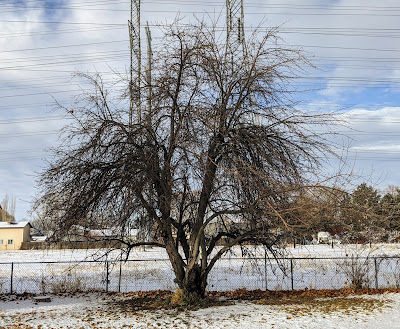Lesson 8: Corrective Pruning
Unfortunately some trees have not been cared for as well as they should have. This lesson will help you understand how to correct problems that are a result of improper pruning or neglect. Turning around an old tree can be done, but it takes a good strategy and a few years of corrective pruning.
 |
| Neglected Apple Tree Before Pruning |
When corrective pruning, there are two types of neglected trees. Some are structurally sound, but did not receive regular pruning for several years. Others lack a good structure or have been so poorly formed by physical damage, disease, or incorrect pruning that they need to be redirected.
If your tree has a good structure, but missed several years of pruning, then you will want to find out how many years since the last pruning. This can be done by counting the terminal bud scars back to an old pruning cut. I will often ask my customers how long it has been since their tree has been pruned. If they say 5 years, then I will inform them that I will be doing 5 years of pruning today. This will allow a customer to expect a drastic change in their tree. (Sometimes customers will say 5, but I can count terminal bud scars and find out exactly how long it has been.)
 |
| Count Terminal Bud Scars Back to Last Pruning Cut |
This is where gardeners ask, "what about the one-third rule?" If you are not familiar with the one-third rule, it states that a gardener should never take more than one third of the canopy at any given pruning. I have seen young fruit trees double in size in a single year. What if your tree grows 40% every year and you are only removing 33%? Eventually your tree will get bigger than you want it to be. When dealing with something as organic as fruit trees, math doesn't really apply. The one-third rule is a guideline and not a hard fast rule.
 |
| Large Pruning Cuts Get Harder to Make Each Year |
Ok, so what about trees that do not have a good structure? Well, this takes a little more time and patience. Remember in lesson 6 about structural pruning? In step 2, we removed the lower two branches every year until the canopy was at the desired height. Then we removed the leader to stop the tree from getting any taller. Corrective pruning is similar, but in reverse. The goal is to create a structurally sound canopy within the existing dysfunctional canopy.
 |
| Create a Canopy Within the Canopy |
Before we explain how this is done, let's review lesson 1 and fruit tree biology. Remember when we talked about leaves creating sugars and passing the surplus to branches, trunks, and roots? What if the sugar runs out before it reaches the roots? Well, eventually the tree will starve and die. Don't get too worried though, trees can tell when this is about to happen and they do everything in their power to avoid death. If a fruit tree is not receiving enough energy to the roots, it will grow adventitious branches closer to the root system. An adventitious branch is another term for a water sprout, and an aggressive pruning will stimulate water sprouts closer to the base of the tree.
 |
| A Heavy Pruning Will Stimulate Water Sprouts |
So the first step to corrective pruning is to give your fruit tree a heavy pruning. Next, you will want to give your tree a season to develop adventitious branches. When you prune your tree the next spring, continue to cut away large branches and tip the new water sprouts to a bud pointing in the direction that you want your new canopy to grow. Over a five (or so) year period, you will eventually replace old dysfunctional branches with new structurally sound ones.
 |
| Make Large Cuts After New Branches Mature |
With a good strategy and several years of pruning, you can correct form and structure on old mature trees. It's unfortunate to see fruit trees miss pruning or get neglected, but it's even more unfortunate to see a fruit tree turn into fire wood instead of return to a healthy productive tree.
Click Here to help us improve this course.



Wow, that was so so so easy to understand, except 1 bit in No 7, I'm still confused. I have read about pruning before but have never quite got to grips with it, so i have 3 neglected peach trees, that i feel so much more confident about tackling. I'm in the Southern Hemisphere New Zealand. Thanks a whole lot, you have made my day, i find it difficult to find someone who knows how to prune.
ReplyDeleteI'm so glad that you were able to make sense of these lessons. Let me know what parts you still find confusing.
Delete